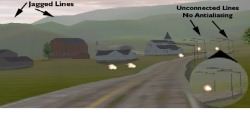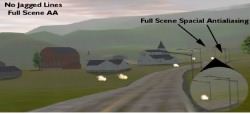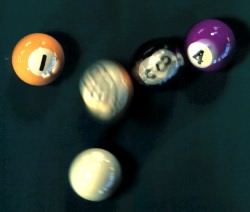|
3dfx: T-Buffer Technology
by Bubba "Masterfung" Wolford |
||||
|
The New Technology What spatial anti-aliasing does is take basic anti-aliasing a huge step further and remove all the jaggedness and polygonal popping from every scene rendered on the PC. The further difference to prior technology is that this rendering will be done on the 3D chip and not via software so we will suffer no loss of CPU horsepower in our game. The result of all this processing and cleaning is an image that is like no other you have seen before on a PC. Explaining the difference is almost impossible for words. It is virtually breathtaking. The difference, literally, is night and day. The crispness, brilliance and clarity that the T-Buffer produces is like nothing I have ever seen before.
 Click for full size image. This is what you're seeing now when playing any game. Not too bad but it could look MUCH better. Notice the heavily jagged lines along the hills and the tops of all those houses' roofs? Look at those phone poles! UGLY! Want the best news about real-time spatial AA? All games that you already own will automatically be rendered with real-time full screen spatial anti-aliasing as soon as you put in the new 3dfx 3D card. No drivers will need to be installed, no extra hardware to make it work, no special patches. Nothing. It will work automatically with every 3D game you own. AWESOME!
 Meet 3dfx T-Buffer technology running Full Scene Spacial Anti-aliasing. This image is looking MUCH better! Notice the jagged lines are gone? Look at those phone poles now. They look realistic. Even the fires in the scene are rendered much better. This picture is a nice example but justice is not served until you have seen it at 60 FPS! Did someone say 32-bit color? * Images Copyright 1998, Mango Grits, Inc. Don't go out celebrating yet though, we are only about one-third of the way to explaining all that T-Buffer can do. There is more. |
Motion Blur There are other forms of anti-aliasing (AA) that 3dfx thinks are important to recognize. Another AA technique is called "temporal" anti-aliasing. We talked about aliasing earlier in that it is the process whereby not enough sampled data is stored in memory due to memory bandwidth restrictions (in other words, not enough memory). This also results in many images that would normally be seen by our eyes (as in a movie or just everyday things) to not be sampled by the chipset due to memory issues on the 3D card. What we get in return for this lack of sampling is clear pictures that when slowed down seem to "jump" from one place to another much like we see from hard-drawn cartoons on TV. What temporal aliasing does is "supersample" images and store more images to the 3D card's memory, allowing for a "blurring" effect much like we see in movies today and real-life. Thus the next time you see a MiG-29 overshoot your F-16, he may do so at such speed to actually produce a blurring effect on your screen, a more realistic experience. Seeing the demo 3dfx offered to us made it clear that blurring effects can add a great deal of reality to the environment.
 You can see the blurring in this image. Can you imagine the possibilities of seeing this kind of technology running on hardware for your PC? Game producers must be licking their chops! * Image Copyright The Association For Computing Machinery. Again, this is another result of the T-Buffer technology. Using temporal anti-aliasing will be something that game designers will have to incorporate into their games, unlike spatial anti-aliasing which is effective without specific software support. Both spatial and temporal anti-aliasing will be driven through hardware to ensure that in no way do these solutions reduce the frame rate in our games. Go to Page Three: Focus on DoF
|
|||
|
Copyright © 1997 - 2000 COMBATSIM.COM, INC. All Rights Reserved. Last Updated July 27th, 1999 |
||||
